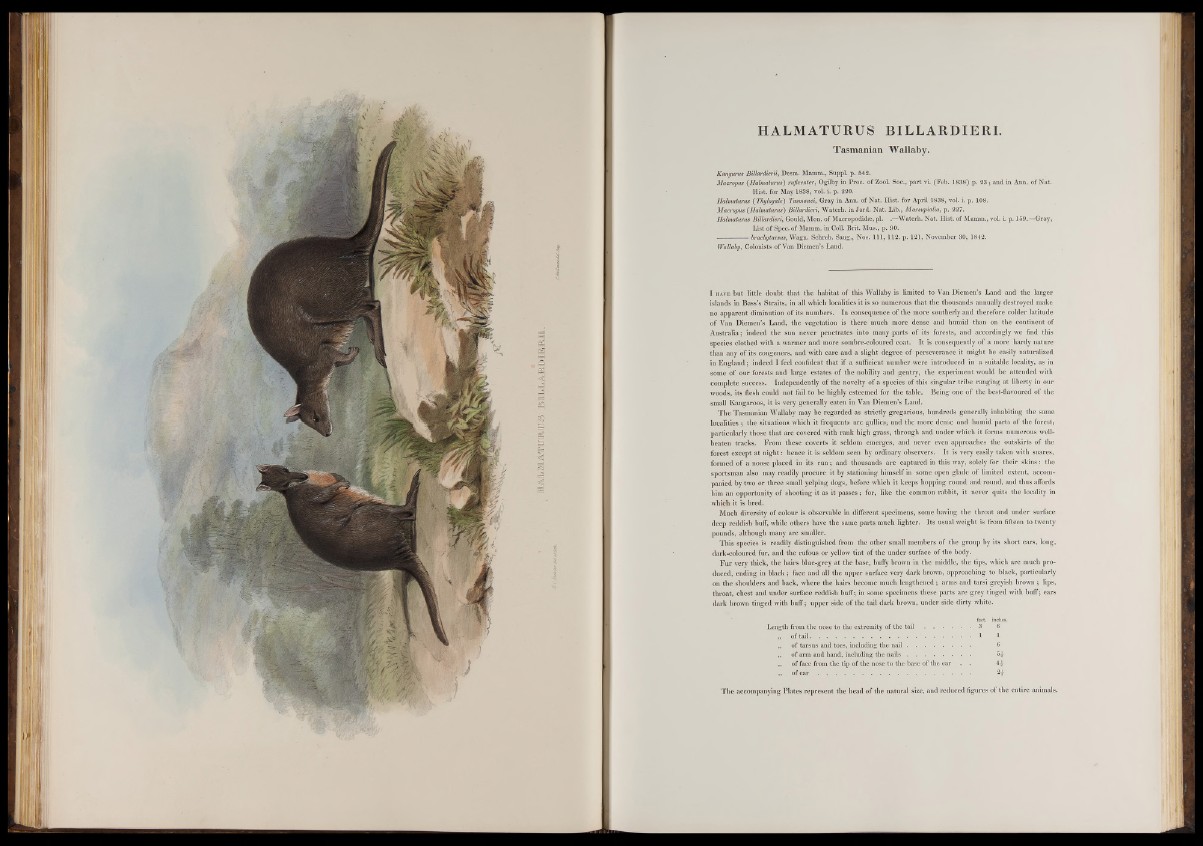
* ' BlULLAffi.BIER.KI.
HALMATURUS BILLARDIERI.
Tasmanian Wallaby.
Kängurus Billardierii, Desm.' Mamm., Suppl. p. 542.
Macropus (Halmaturus) rufiventer, Ogilby.in Proc. of Zool. See., part vi. (Feb. 1838) p. 23 ; and in Ann. of Nat.
• Hist, for May 1838, vol. i. p. 220.
Halmaturus (Thylogàle) Tasmanei, Gray in Ann. of Nat. Hist, for April 1838, vol. i. p. 108.
Macropus (JHalmatwrus) Biliardieri, Waterh. in Jard. Nat. Lib., MarsupiaUa, p. 227.
Halmaturus Biliardieri, Gould, Mon. of Macropodidse, pi. .—Waterh. Nat. Hist, of Mamm., vol. i. p. 159. —Gray,
List of Spec, of Mamm. in Coll. Brit. Mus., p. 90.
--------------brachy tarsus, Waga. Schreb. Saug., Nos. I l l , 112. p. 121, November 30, 1842.
Wallaby, Colonists of Van Diemen’s Land.
I h a v e but little doubt tbat the habitat of this Wallaby is limited to Van Diemen’s Land and the larger
islands in Bass’s Straits, in all which localities it is so numerous that the thousands annually destroyed make
no apparent diminution of its numbers. In consequence of the more southerly and therefore colder latitude
of Van Diemen’s Land, the vegetation is there much more dense and humid than on the continent of
Australia; indeed the sun never penetrates into many parts of its forests, and accordingly we find this
species clothed with a warmer and more sombre-coloured coat. It is consequently of a more hardy nature
than any of its congeners, and with care and a slight degree of perseverance it might be easily naturalized
in England; indeed I feel confident that if a sufficient uumber were introduced in a suitable locality, as in
some of our forests and large estates of the nobility and gentry, the experiment would be attended with
complete success. Independently of the novelty of a species of this singular tribe ranging at liberty in our
woods, its flesh could not fail to be highly esteemed for the table. Being one of the best-flavoured of the
small Kangaroos, it is very generally eaten in Van Diemen’s Land.
The Tasmanian Wallaby may he regarded as strictly gregarious, hundreds generally inhabiting the same
localities ; the situations which it frequents are gullies, and the more dense and humid parts of the forest,
particularly those that are covered with rank high grass, through and under which it forms numerous well-
beaten tracks. From these coverts it seldom emerges, and never even approaches the outskirts of the
forest except at night: hence it is seldom seen by ordinary observers. It is very easily taken with snares,
formed of a noose placed in its ru n ; and thousands are captured in this way, solely for their skins: the
sportsman also may readily procure it by stationing himself in some open glade of limited extent, accompanied
by two or three small yelping dogs, before which it keeps hopping round and round, and thus affords
him an opportunity of shooting it as it passes; for, like the common rabbit, it never quits the locality in
which it is bred.
Much diversity of colour is observable in different specimens, some having the throat and under surface
deep reddish buff, while others have the same parts much lighter. Its usual weight is from fifteen to twenty
pounds, although many are smaller.
This species is readily distinguished from the other small members of the group by its short ears, long,
dark-coloured fur, and the rufous or yellow tint of the under surface of the body.
Fur very thick, the hairs blue-grey at the base, bufly brown in the middle, the tips, which are much produced,
ending in black; face and all the upper surface very dark brown, approaching to black, particularly
on the shoulders and back, where the hairs become much lengthened; arms and tarsi greyish brown ; lips,
throat, chest and under surface reddish buff; in some specimens these parts are grey tinged with buff; ears
dark brown tinged with buff; upper side of the tail dark brown, under side dirty white.
feet, inches.
Length from the nose to the extremity of the t a i l 3 6
,, of tail.......................................................................................................1 1
„ of tarsus and toes, including the n a i l ...................................... 6
,, of arm and hand, including the n a i l s .............................................. 5-j-
„ of face from the tip of the nose to the base of the ear . . 4£
,, of e a r ................................................................................... 2 r
The accompanying Plates represent the head of the natural size, and reduced figures of the entire animals.